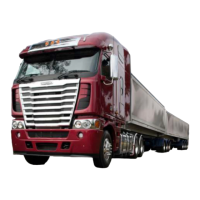Whenever vehicle braking is required on good road
conditions, the engine brake may be used in con-
junction with the service brakes. There is no time
limit for operation of the engine brake. However, an
engine brake does not provide the precise control
available from the service brakes, and is not a sub-
stitute for a service braking system.
WARNING
Usage of the engine brake as the primary braking
system can cause unpredictable stopping dis-
tances, that could result in personal injury or
property damage. Service brakes are the primary
vehicle braking system.
There are two switches that control the engine brake.
•
The dash mounted ON/OFF switch (ENG
BRK), is used to turn the engine brake ON and
OFF. See
Fig. 12.5.
•
The HI/MED/LO (in some cases HI/LO) engine
brake level switch on the dash, controls the
amount of engine braking.
Since the engine brake is most effective at rated en-
gine speed, gear selection is very important. Gearing
down the vehicle, within the limits of the rated engine
speed, makes the engine brake more effective. Rec-
ommended engine braking speed is above 1800 rpm
and below the rated speed.
WARNING
The engine brake must be disengaged when
shifting gears using the clutch pedal. If the en-
gine brake is engaged when the transmission is
in neutral, the braking power of the engine brake
can stall the engine, which could result in loss of
vehicle control, possibly causing personal injury
and property damage.
NOTICE
Do not allow the engine to exceed 2500 rpm. Se-
rious engine damage could result.
"Control speed" is the speed at which the engine
brake performs 100 percent of the required downhill
braking, resulting in a constant speed of descent.
The control speed varies, depending on vehicle
weight and the downhill grade.
For faster descent, select a higher gear than that
used for control speed. Service brakes must then be
used intermittently to prevent engine overspeed and
to maintain desired vehicle speed.
A driver may descend slower than control speed by
selecting a lower gear, being careful not to over-
speed the engine. Occasional deactivation of the en-
gine brake may be necessary to maintain the desig-
nated road speed under these conditions.
Below a set engine temperature when the engine is
cold, the brake may be disabled depending on the
brake type.
Engine Brake Operation
To activate the engine brake after the engine is
warmed up and the vehicle is in motion:
•
Remove your feet from both the clutch and
throttle pedals. Press the dash-mounted ENG
BRK switch to toggle the engine brake ON.
See
Fig. 12.4.
The engine brake will engage at the rate last
set on the brake intensity switch.
•
Move the intensity switch to the desired inten-
sity. Depending on the engine model, LO will
provide 1/3 or 1/2 of the full braking capacity of
the engine. HI will provide maximum engine
braking.
08/12/2009
f611039
12
1. Engine Brake ON/OFF
2. Engine Brake Intensity Switch
Fig. 12.5, Engine Brake Switches
Brake System
12.6

